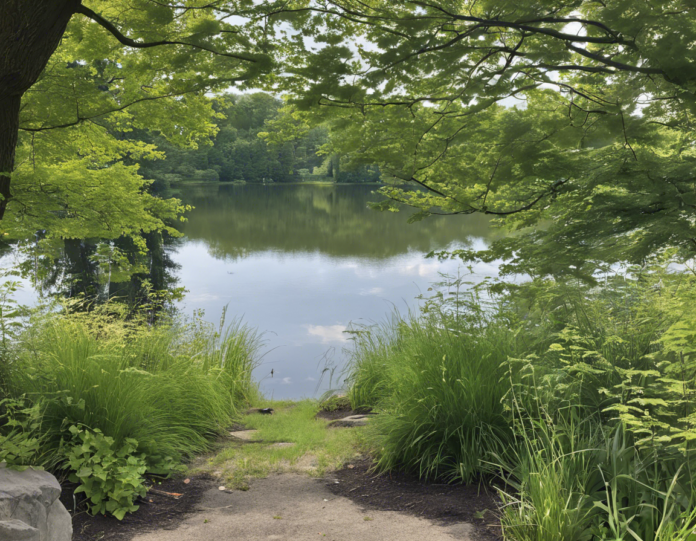Introduction
Whitmore Lake, a charming village nestled in the state of Michigan, is a hidden gem for nature lovers and outdoor enthusiasts. The serene lake, lush forests, and scenic trails make it an ideal destination for those seeking a peaceful retreat in the midst of nature’s beauty. In this guide, we will delve into the planted beauty of Whitmore Lake, exploring its botanical wonders that captivate visitors year-round.
The Flora of Whitmore Lake
Whitmore Lake boasts a diverse array of plant species that contribute to its vibrant ecosystem. From native wildflowers to towering trees, the flora of Whitmore Lake enchants visitors with its natural splendor. Here are some notable plants found in the area:
Native Wildflowers
* Trillium: The delicate white petals of the Trillium bloom in the spring, carpeting the forest floor with their elegant presence.
* Bloodroot: Known for its striking white flowers and unique foliage, Bloodroot adds a touch of whimsy to the woodlands.
* Jack-in-the-Pulpit: This unusual plant, with its hooded flower resembling a preacher in a pulpit, is a fascinating find for botanical enthusiasts.
Trees
* Oak: Majestic Oak trees dot the landscape of Whitmore Lake, providing shade and shelter for a variety of wildlife.
* Maple: The vibrant foliage of Maples in the fall transforms the area into a kaleidoscope of reds, oranges, and yellows.
* Pine: Towering Pine trees stand tall against the sky, their evergreen needles a testament to resilience and endurance.
Shrubs and Bushes
* Blueberry Bushes: In the summer, the sweet berries of Blueberry bushes attract both humans and animals alike, offering a delicious treat.
* Witch Hazel: Known for its unusual flowers that bloom in late fall or winter, Witch Hazel adds a touch of color to the winter landscape.
The Botanical Gardens of Whitmore Lake
For those seeking a curated botanical experience, the Botanical Gardens of Whitmore Lake are a must-visit destination. These meticulously landscaped gardens showcase a wide variety of plant species from around the world, offering visitors a glimpse into the beauty and diversity of the botanical kingdom. Stroll through themed gardens such as the Rose Garden, Japanese Garden, and Succulent Garden, each offering a unique sensory experience.
Exploring the Trails
One of the best ways to immerse yourself in the planted beauty of Whitmore Lake is by exploring its network of trails. Whether you prefer a leisurely stroll or a challenging hike, the trails in the area cater to all skill levels and interests. Some popular trails to explore include:
Lake Loop Trail: This scenic trail winds around the perimeter of the lake, offering breathtaking views of the water and surrounding landscape.
Forest Adventure Trail: Traverse through dense forests and meadows on this adventurous trail, where you might spot a variety of plant species along the way.
Wildflower Walk: Embark on this guided walk led by local botanists to discover the seasonal wildflowers that bloom in the area.
Tips for Plant Enthusiasts
For avid plant enthusiasts looking to fully immerse themselves in the botanical wonders of Whitmore Lake, here are some tips to make the most of your visit:
Bring a Field Guide: Pack a field guide specific to the flora of the region to help identify plant species you encounter during your explorations.
Join a Guided Tour: Sign up for a guided botanical tour led by local experts to gain in-depth knowledge about the plants and their ecological significance.
Visit in Different Seasons: Whitmore Lake’s beauty changes with the seasons, so plan multiple visits throughout the year to witness the diverse flora in bloom.
Frequently Asked Questions (FAQs)
1. Is Whitmore Lake only a summer destination for plant enthusiasts?
– While summer showcases an abundance of blooms, Whitmore Lake offers plant beauty year-round, with each season bringing its own unique flora.
- Can I forage for edible plants in Whitmore Lake?
-
While some plants like Blueberries are safe to consume, it’s important to be well-versed in plant identification and foraging safety before consuming any wild plants.
-
Are there any rare or endangered plant species in Whitmore Lake?
-
Whitmore Lake is home to a variety of plant species, some of which may be rare or endangered. Admire these plants from a distance to help preserve their fragile habitats.
-
What should I do if I encounter a plant I can’t identify?
-
Take a photo of the plant and consult with local botanical experts or online plant identification forums to help identify the species safely.
-
Are there any plant-related events or festivals held in Whitmore Lake?
- Whitmore Lake hosts occasional plant-related events, workshops, and guided walks for enthusiasts to learn more about the local flora. Check local event listings for upcoming activities.
In conclusion, Whitmore Lake’s planted beauty is a testament to nature’s artistry and resilience. Whether you’re a seasoned botanist or a casual nature lover, exploring the flora of Whitmore Lake is a rewarding experience that fosters a deeper connection to the natural world. Plan your visit to this botanical paradise and immerse yourself in the lush landscapes and verdant beauty that await.








